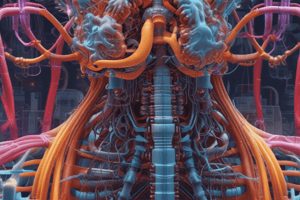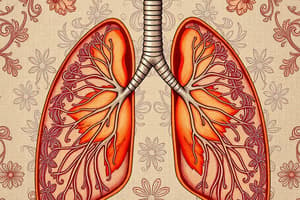Podcast
Questions and Answers
What is a Ventilation Limited Fire?
What is a Ventilation Limited Fire?
- A fire that is easily extinguished
- A fire that produces no smoke
- A fire that burns at a constant rate
- A fire in which the heat release rate and fire growth are regulated by the available oxygen within the space (correct)
What are the 3 critical points of a Ventilation Limited Fire graph?
What are the 3 critical points of a Ventilation Limited Fire graph?
Ignition, Fire under ventilated, Fire Dept. vents
What is the flow path in a fire?
What is the flow path in a fire?
The movement of heat and smoke from the higher pressure within the fire area toward the lower-pressure areas accessible by doors, window openings, and roof structures.
What is a neutral plane?
What is a neutral plane?
What is a fire plume?
What is a fire plume?
The flow to and from a fire determines the _________________ and _________________ of fire growth.
The flow to and from a fire determines the _________________ and _________________ of fire growth.
What is air entrainment?
What is air entrainment?
What are the 3 zones of a fire plume structure?
What are the 3 zones of a fire plume structure?
In what zone(s) of the fire plume structure are there high turbulence intensity?
In what zone(s) of the fire plume structure are there high turbulence intensity?
In what zone(s) of the fire plume structure is there combustion?
In what zone(s) of the fire plume structure is there combustion?
In what zone(s) of the fire plume structure do the flames cease?
In what zone(s) of the fire plume structure do the flames cease?
What is the luminous flame zone (Zone 1)?
What is the luminous flame zone (Zone 1)?
What is the intermittent flame zone (Zone 2)?
What is the intermittent flame zone (Zone 2)?
What is the buoyant plume zone (Zone 3)?
What is the buoyant plume zone (Zone 3)?
What is luminous flame height?
What is luminous flame height?
How does the diameter of the plume change?
How does the diameter of the plume change?
How does average midline temperature change with height?
How does average midline temperature change with height?
How does average midline velocity change with height?
How does average midline velocity change with height?
What is a ceiling jet (CJ)?
What is a ceiling jet (CJ)?
In a vent-limited fire, what 2 things happen?
In a vent-limited fire, what 2 things happen?
What does air entrainment depend on?
What does air entrainment depend on?
Heat loss from the hot layer to the ceiling creates ________ on rate of outflow.
Heat loss from the hot layer to the ceiling creates ________ on rate of outflow.
Heat loss depends on what 3 things?
Heat loss depends on what 3 things?
What is the stack effect in a tall building?
What is the stack effect in a tall building?
True/False: The lowest zone is luminous; the gases accelerate upward.
True/False: The lowest zone is luminous; the gases accelerate upward.
True/False: When a fire plume hits a ceiling, it spreads horizontally.
True/False: When a fire plume hits a ceiling, it spreads horizontally.
What are the 3 concepts of reading smoke?
What are the 3 concepts of reading smoke?
What are the 4 steps to reading a fire?
What are the 4 steps to reading a fire?
What are the 4 key attributes of smoke?
What are the 4 key attributes of smoke?
What color is smoke that indicates early-stage heating?
What color is smoke that indicates early-stage heating?
What color is smoke that comes from unfinished wood as it approaches late-stage heating?
What color is smoke that comes from unfinished wood as it approaches late-stage heating?
What color is smoke that is high-volume, turbulent, and ultra-dense, indicating impending autoignition?
What color is smoke that is high-volume, turbulent, and ultra-dense, indicating impending autoignition?
What color is smoke from plastics and painted/stained surfaces?
What color is smoke from plastics and painted/stained surfaces?
Flashcards are hidden until you start studying
Study Notes
Ventilation Limited Fire
- Characterized by fire growth restricted by available oxygen.
- Heat release rate directly correlates to oxygen supply.
Critical Points of Ventilation Limited Fire
- Key factors include ignition, fire under-ventilation, and fire department interventions.
Flow Path
- Describes heat and smoke movement from high-pressure fire areas to lower-pressure exits like doors and windows.
Neutral Plane
- The horizontal interface between hot upper gases and cooler lower layers in a fire environment.
Fire Plume
- Defined as the vertical column of hot gases, flames, and smoke emitted during a fire.
Factors Influencing Fire Growth
- Magnitude and direction of flow are essential in determining fire growth dynamics.
Air Entrainment
- The process by which air is drawn into a fire plume, influenced by the plume's buoyant movement.
Zones of Fire Plume Structure
- Three zones: luminous flame zone (constantly upward accelerating gases), intermittently flaming zone, and buoyant plume zone (ascending gases losing momentum).
Turbulence Intensity
- High turbulence is noted in zones 2 and 3, indicating chaotic fire behavior.
Combustion Activity
- Combustion occurs in zones 1 and 2, highlighted by the presence of flames.
Flame Behavior in Fire Zones
- Zone 3 is where flames cease, marking the end of active combustion.
Characteristics of Flame Zones
- Zone 1: Luminous flame zone; gases accelerate upwards.
- Zone 2: Intermittent flaming; consistent upward velocity.
- Zone 3: Buoyant plume; gases experience a decrease in height.
Flame Height Measurement
- Luminous flame height measures the distance from the flame base to a point where the plume is evenly luminous and transparent.
Plume Diameter
- Plume diameter increases proportionally to height, affecting dispersion.
Temperature Distribution
- Average midline temperature drops inversely proportional to height raised to 5/3.
- Average midline velocity declines inversely proportional to height raised to 1/3.
Ceiling Jet (CJ)
- Radial outward flow beneath the ceiling caused by fire plume impacts.
Vent-Limited Fire Dynamics
- Involves application of the ideal gas law and oxygen depletion during combustion.
Air Entrainment Rate
- Proportional to both the burn rate and the vertical distance between the plume base and the neutral plane.
Heat Loss Effects
- "Drag" effects on outflow rate are influenced by heat loss to ceilings and upper walls.
Heat Loss Determinants
- Dependent on thermal inertia of walls, heat capacity of upper-layer gases, and turbulence degree in the upper layer.
Stack Effect
- The vertical airflow in tall buildings caused by temperature differences between indoors and outdoors.
Smoke Characteristics
- Reading smoke entails identifying its fuel properties, changes in fuel composition, and possible "triggers" for events.
Steps to Reading a Fire
- Evaluate key smoke attributes, weigh contributing factors, judge rate of change, and predict future fire behavior.
Key Attributes of Smoke
- Volume, velocity (pressure), density, and color essential for assessing fire conditions.
Smoke Colors and Their Implications
- White smoke: slow, low-pressure, indicates early heating stages.
- Brown smoke: from unfinished wood, signifies late heating stages.
- Black smoke: high volume, turbulent, indicates imminent autoignition.
- Gray smoke: results from burning plastic and surfaces, due to moisture and hydrocarbons interaction.
Studying That Suits You
Use AI to generate personalized quizzes and flashcards to suit your learning preferences.



